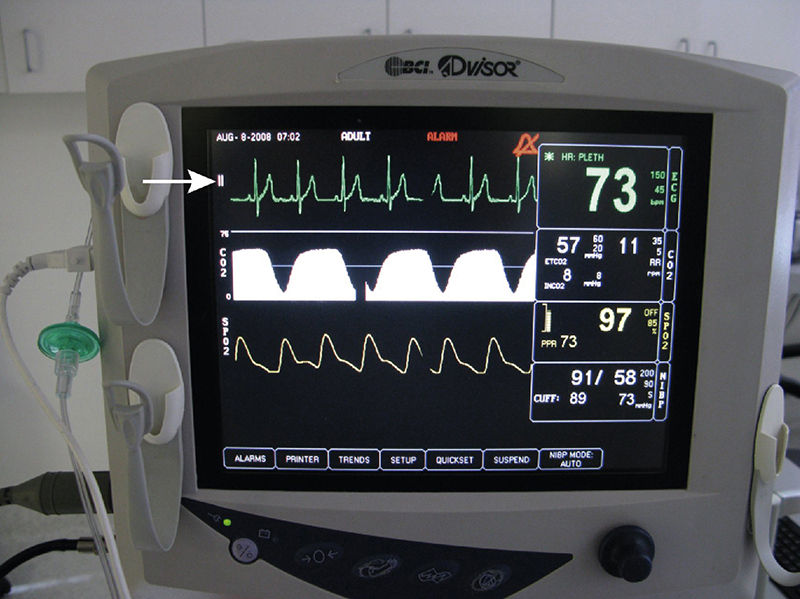In the second part of this chapter we begin a discussion of anesthesia. The term anesthesia literally means “without sensation.” The patient may be conscious or unconscious, but while receiving any type of anesthesia, he or she should not perceive pain. The precise chemical and physiological means by which anesthetics work are not yet fully clear, but we do know that the mechanism depends on the type of agent being administered. For example, some drugs induce amnesia, whereas others induce unconsciousness or change the perception of pain. There are four major types of anesthetic techniques: sedation/MAC, local, regional, and general. This chapter presents a brief description of sedation/MAC and basic information on local and regional anesthesia. Basic concepts of general anesthesia are covered in Chapter 15.
Patient Monitoring
Each of the patient’s vital signs is continuously monitored during surgical intervention. Continuous monitoring provides a means to rapidly identify changes in the patient’s physiological status. The first line of patient monitoring is direct observation of the patient by the anesthesia care provider, and its importance cannot be underestimated. The patient’s oxygen saturation is monitored by direct observation and by use of the pulse oximeter. Respiration is monitored by patient observation and, when the patient is under heavy sedation or general anesthesia, by measurement of levels of expired carbon dioxide. Circulation is monitored by continuous electrocardiography (rate and rhythm) and by frequent measurement of blood pressure (BP). Temperature is assessed by various methods, as indicated by the patient’s situation. During general anesthesia the patient’s neuromuscular function and level of awareness are monitored when indicated. Certain patient conditions and some particular surgical procedures may require advanced or invasive monitoring methods, such as placement of arterial or central venous pressure lines. See Box 14-1 for a summary of the most common physiological functions monitored in the surgical patient.
 Make it Simple
Make it SimpleThe complex nature of surgical patient monitoring can be simplified by applying the principles of cardiopulmonary resuscitation (CPR): airway, breathing, and circulation (ABC). While under local or regional anesthesia, the patient maintains his or her own airway (oxygenation), and it is confirmed by pulse oximetry. With the patient under general anesthesia, the airway is secured with an endotracheal tube or laryngeal masked airway. In some instances of general anesthesia the patient’s airway is controlled via bag/mask ventilation by the anesthesia care provider. Breathing (respiration) is monitored by direct observation, confirmed with the pulse oximeter and capnography, and controlled or assisted by an anesthesia care provider when the patient is under general anesthesia. Circulation is monitored by electrocardiography and BP.
Electrocardiography
The patient’s heart rate and rhythm will be continually assessed with electrocardiography. Electrocardiography is the process of recording the electrical impulses of the heart. Electrodes that sense the electrical activity of the heart are placed on the patient’s skin and attached to leads, which transmit those electrical impulses to the electrocardiograph (ECG) device (Fig. 14-1). The electrical activity of the heart is recorded and displayed on a screen. The ECG may be set to record a tracing of the electrical activity on a strip of paper. The ECG device is also set to emit an audible signal to indicate heart rate and rhythm.

FIGURE 14-1 Vital signs monitor, includes carbon dioxide (arrow indicates ECG). (From Malamed SF: Sedation, ed 5, St Louis, 2010, Elsevier.)
 Caution
CautionFor patient safety the audible ECG signal must be set loud enough to be heard by the anesthesia care provider over extraneous operating room noise.
The ECG may be recorded with three- or five-lead systems. The surgical technologist in the circulating role may assist the anesthesia care provider in placing the electrodes, which should be securely adhered to areas of clean, dry skin. The electrodes should be protected from preparation solutions and placed so that a change in the patient’s position (e.g., supine to lateral) will not disrupt electrode contact. In a five-lead system, electrodes are placed on each shoulder, each hip, and in the fifth intercostal space near the left anterior axillary line. A baseline reading is obtained, and the ECG is used to monitor changes in the heart rate and rhythm during surgery.
The ECG is supplemented by auscultation (listening to the sounds of the chest [e.g., the heart rate, rhythm, and pulmonary sounds]) with a precordial stethoscope. A modified version of a standard stethoscope, the precordial stethoscope is taped onto the patient’s chest at the left sternal border or in the suprasternal notch. Alternatively, an esophageal stethoscope may be used, particularly if the chest is prepped into the sterile field. A long piece of tubing extends from the stethoscope to a specialized earpiece placed in the anesthesia care provider’s ear, thus enabling continuous auscultation. Auscultation is also used to assess respiratory rate and lung sounds and to verify placement of airway devices used in general anesthesia.
 Tech Tip
Tech TipA review of basic physiology of the electrical conduction system of the heart is highly recommended. The surgical technologist should be able to interpret a normal ECG cycle, including the meaning of the P wave, QRS complex, and T wave. By listening to the audible ECG in the background noise of the operating room, the surgical technologist should be able to appreciate various types of dysrhythmias, including bradycardia, tachycardia, and asystole. In addition, the surgical technologist should be able to identify a premature ventricular contraction (PVC) and the presence of an active pacemaker by its characteristic spike. Each of these abilities contributes to the surgical technologist’s value as a surgical team member. The ability to recognize and appreciate the importance of changes in heart rate and rhythm enables the surgical technologist to provide assistance to the anesthesia care provider and patient when necessary.
< div class='tao-gold-member'>
Only gold members can continue reading. Log In or Register to continue
Stay updated, free articles. Join our Telegram channel

Full access? Get Clinical Tree



